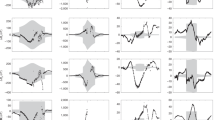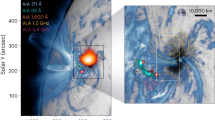Abstract
The Earth, Jupiter and Saturn emit non-thermal low-frequency radiations with similar characteristics. For the Earth and Saturn, the radio emissions are known to fluctuate with a time scale of several days, correlated with variations of the solar wind or related phenomena at the planet1–4. Several studies of the jovian radiation at decametre wavelengths, from ground-based observations, suggest that the non-Io-controlled emission fluctuates in response to the sector structure of the interplanetary magnetic field5–9. We study here the long-term fluctuations of the jovian emission at hectometre and kilometre wavelengths. We use observations from the Planetary Radio Astronomy (PRA) experiment aboard the two Voyager spacecraft. We show that these emissions are strongly affected by the magnetic sector structure at Jupiter. This leads us to discuss the position of the sources of emission in the jovian magneto-sphere.
This is a preview of subscription content, access via your institution
Access options
Subscribe to this journal
Receive 51 print issues and online access
$199.00 per year
only $3.90 per issue
Buy this article
- Purchase on Springer Link
- Instant access to full article PDF
Prices may be subject to local taxes which are calculated during checkout
Similar content being viewed by others
References
Kaiser, M. L. & Alexander, J. K. J. geophys. Res. 82, 5283–5286 (1977).
Voots et al. J. geophys. Res. 82, 2259–2266 (1977).
Benson, R. F. & Calvert, W. Geophys. Res. Lett. 6, 479–482 (1979).
Desch, M. D. J. geophys. Res. 87, 4549–4554 (1982).
Terasawa, T., Maesawa, K. & Machida, S. Nature 273, 131–132 (1978).
Barrow, C. H. J. geophys. Res. 84, 5366–5372 (1979).
Barrow, C. H. Planet Space Sci. 26, 1193–1199 (1978).
Oya, H. & Morioka, A. Planet Space Sci. 29, 783–791 (1981).
Pokorny, Z. Bull. Astr. Inst. Czech. 33, 193–201 (1982).
Kaiser, M. L. & Alexander, J. K. Astrophys. Lett. 14, 55–58 (1973).
Kurth, W. S., Gurnett, D. A. & Scarf, F. L. Geophys. Res. Lett. 7, 61–64 (1980).
Carr, T. D., Desch, M. D. & Alexander, J. K. in Physics of the Jovian Magnetosphere (ed. Dessler, A. J.) 226–284 (Cambridge University Press, 1983).
Lepping, R. P. et al. J. geophys. Res. (submitted).
Hill, T. W., Dessler, A. J. & Goertz, C. K. in Physics of the Jovian Magnetosphere (ed. Dessler, A. J.) 353–394 (Cambridge University Press, 1983).
Author information
Authors and Affiliations
Rights and permissions
About this article
Cite this article
Zarka, P., Genova, F. Low-frequency Jovian emission and solar wind magnetic sector structure. Nature 306, 767–768 (1983). https://doi.org/10.1038/306767a0
Received:
Accepted:
Issue Date:
DOI: https://doi.org/10.1038/306767a0
This article is cited by
-
The Juno Waves Investigation
Space Science Reviews (2017)
-
Auroral Processes at the Giant Planets: Energy Deposition, Emission Mechanisms, Morphology and Spectra
Space Science Reviews (2015)
-
Solar Wind and Internally Driven Dynamics: Influences on Magnetodiscs and Auroral Responses
Space Science Reviews (2015)
-
Solar wind dynamic pressure and electric field as the main factors controlling Saturn's aurorae
Nature (2005)
-
An interplanetary shock traced by planetary auroral storms from the Sun to Saturn
Nature (2004)
Comments
By submitting a comment you agree to abide by our Terms and Community Guidelines. If you find something abusive or that does not comply with our terms or guidelines please flag it as inappropriate.



